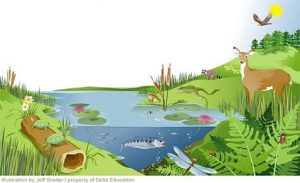 The biological system is a mind boggling interrelationship of abiotic parts (the atmosphere, topography and soils) and biotic segments (the plants and the creatures). These parts don’t exist in a disengaged state out respond to upgrades which might be created from inside the biological system, or from other neighboring environment or from the general condition.
The biological system is a mind boggling interrelationship of abiotic parts (the atmosphere, topography and soils) and biotic segments (the plants and the creatures). These parts don’t exist in a disengaged state out respond to upgrades which might be created from inside the biological system, or from other neighboring environment or from the general condition.
The term ‘condition’ has been utilized by Clarke (1965) to infer the space which encompasses an individual living being, or gatherings of creatures. It is the hyper-space in which the absolute biological system plays out its reality. Similarly as the biological system was demonstrated to be a theoretical model, at that point so too condition is a reflection which has been concocted by environmentalists to help the investigation of biological systems.
Normally, an enormous number of various parts consolidate to shape nature and, subsequently, a response procedure happens between the ecological sources of info and the life form.
Biological system or biocenosis is a section of nature/biosphere comprising of a network of living creatures and the abiotic/physical condition both associating and trading materials between them. Biological system can be brief (for example downpour water lake) or changeless, regular or man-made (for example aquarium, horticulture), little or huge.
Biotic Components:
They incorporate every single living being available in an environment makers, shoppers and decomposers. The parts are associated through food, its contained vitality and a trap of interrelationships.
(A) Producers:
They circular segment autotrophs that make natural mixes from inorganic crude materials with the assistance of sun powered vitality. Makers are likewise called transducers as they convert sunlight based radiations into substance vitality. Other than food, makers give out oxygen and take in carbon dioxide.
(B) Consumers:
They are heterotrophs, for the most part creatures which feed on different life forms. Customers are likewise called phagotrophes as they ingest food. Herbivores/First Order Consumers. They feed on makers. Additionally called key industry creatures (Elton, 1927), for example Deer, Rabbit, Cattle, Goat/Sheep, Grasshopper, protozoans, molluscs, numerous scavangers. Essential Carnivores/second requests buyers. Feed on essential carnivores, for example Owl, Peacock. Top Carnivores. Carnivores which are not gone after, e.g Lion.
(C) Decomposers:
They are saprotrophs which disintegrate the natural stays by emitting extracellular stomach related compounds. Because of corruption of natural remains, decomposers are likewise called reducers. They are otherwise called mineralisers as they discharge minerals caught in natural remains. Detrivores are decomposers, just as scroungers. Scavangers are buyers of dead bodies, for example Vulture, Carrion Beetle. Parasites are customers that feed on little piece of a living being.
Abiotic Components:
(a) Temperature (b) Light (c) Wind/Air ebb and flow (d) Humidity/Precipitution (e) Water (f) Topography (g) Back ground. Trophic Levels
They are steps or divisions of natural way of life described by explicit technique for acquiring food. Makers have a place with T or first trophic level, herbivores/essential purchasers T,, essential carnivores/optional shoppers Tv auxiliary carnivores T4 and so forth. Parasites don’t have any fixed trophic level. Decomposers establish the last or deteritus trophic level. Organization is the gathering of species having a place with the equivalent trophic level and abusing a similar asset.
(A) Food Chain:
It is the grouping of populaces/life forms through which food and its contained vitality go in an environment with individuals at one stage turning out to be food of later advance of the succession. Regular natural ways of life are predator evolved ways of life.
Waste natural way of life is the most brief. Parasitic natural pecking order is the third sort.
(an) Aquatic Food Chain:
Phytoplankton – > Zooplankton – > Small
Shellfish – > Water Insects – > Small Fish – > Larger
Fish – > King Fishes.
(b) Land Food Chain:
Grass – > Grasshopper – > Frog – » Snake – > Peacock – > Falcon – > Eagle.
Spices – > Rabbit – > Fox – > Wolf – > Tiger
(B) Food Web:
It is a system of natural ways of life which are interconnected at various trophic levels in order to shape various taking care of associations among individuals from a biotic network, for example Hares went after by Wild canine, Fox, Wild feline and Jackal. These carnivores can likewise go after mice, vixens, and squarrels. Wolf goes after Jackal, Fox, Wild feline and Sheep/goat. It is eaten by Tiger. Tiger goes after Deer, Antelope and various different creatures. In Sunderbans, Tiger doesn’t have its normal preys. It takes care of there on fish and crabs.
Stream of Energy:
Biological system is consistently acquiring sun powered vitality which is caught by makers 1.15% in prairies, 0.9% in Savannah, 0.81 % in blended woodland, 5% in yields and 10-12% in sugarcane. The rest is disseminated as warmth. A piece of vitality put away in food is discharged during breath.
A portion of the discharged vitality is utilized in doing body exercises while the rest is disseminated. Herbivores feed on makers. Some portion of the food vitality is squandered in absorption and osmosis. A portion of the acclimatized food is separated to discharge vitality for performing body exercises.
A portion of the vitality is lost as warmth. A little bit turns out to be a piece of the assortment of herbivore. Herbivores are eaten by essential carnivores, the last by optional carnivores, etc. At each progression, a great deal of vitality is squandered. Stream of vitality in a biological system is unidirectional.
